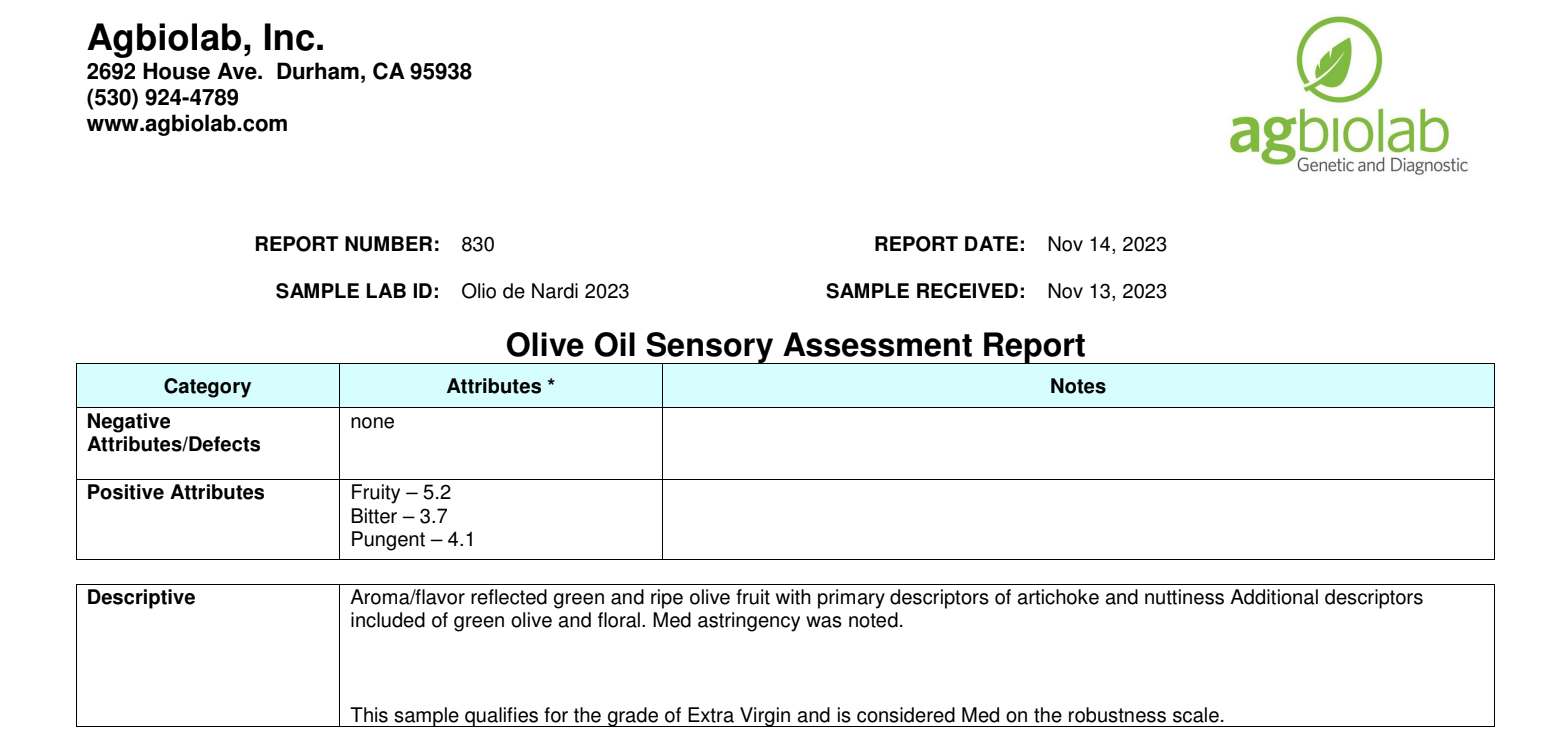What makes extra-virgin olive oil "extra-virgin"?
In order to be classified as "extra-virgin olive oil", the oil must pass both a chemical analysis and a sensory analysis. The chemical analysis tests the level of Free Fatty Acid (FFA) of the oil, which must be <= 0.5% (California standard), or <=0.8% (International standard). High values are an
indicator of poor fruit quality or improper handling prior to milling, as free acidity arises from the hydrolytic breakdown of the oil.
For the sensory analysis, certified IOC (International Olive Council) olive oil taster(s) must be able to detect some fruity characteristics on the oil (either by smell or taste) and the oil must have zero "defects". The oil is then given an intensity score of the three positive attributes of EVOO: fruitiness, pungency and bitterness. Any oil that doesn't meet EITHER of the standards above cannot be classified as "extra-virgin".
indicator of poor fruit quality or improper handling prior to milling, as free acidity arises from the hydrolytic breakdown of the oil.
For the sensory analysis, certified IOC (International Olive Council) olive oil taster(s) must be able to detect some fruity characteristics on the oil (either by smell or taste) and the oil must have zero "defects". The oil is then given an intensity score of the three positive attributes of EVOO: fruitiness, pungency and bitterness. Any oil that doesn't meet EITHER of the standards above cannot be classified as "extra-virgin".
Is Olio De Nardi classified as extra-virgin?
Yes! Our 2023 Estate blend EVOO has been certified as "extra-virgin olive oil", adhering to the guidelines set by the California Olive Oil Council (COOC).
- FFA (Free-fatty acid): 0.28%
- Fruity 5.2 / Bitter 3.7 / Pungent 4.1
- Defects: 0
* Analysis was completed by AgBio Labs, CA on 11/15/23.
- FFA (Free-fatty acid): 0.28%
- Fruity 5.2 / Bitter 3.7 / Pungent 4.1
- Defects: 0
* Analysis was completed by AgBio Labs, CA on 11/15/23.
What does "cold press" and "first press" olive oil really mean?
The terms "cold press" and "first press" are slightly antiquated terms used to describe extra-virgin olive oil. "Cold Press" refers to the temperature of the olive paste as it's being processed into olive oil. Extra-virgin olive oil cannot exceed a temperature (during the milling process) of 30C/86F, so this is commonly referred to as "cold pressed". After the initial pressing of extra-virgin olive oil, producers can apply extreme heat to the olive paste to extract additional oil. This oil (Virgin Olive Oil, Olive Oil, Extra-Light Olive Oil) will be void of flavor, and contain very little to zero health benefits compared to extra-virgin olive oil. "First Press" refers to the first extraction of oil from the olive paste. Just because a label says "cold press" or "first press" does not mean that it's extra-virgin olive oil (see above).
Your EVOO is always sold out. How can I get some?
We wish we had enough supply to meet demand, but we always sell out before the next harvest. If you join the EVOOLUTION Club, we set aside your oil for the rest of the year. That's the only way to guarantee that you can enjoy Olio De Nardi throughout the year.
What if I receive the wrong order or a damaged bottle?
We make every effort to ship the correct order and package the bottles to prevent breakage. If an order is incorrect, or you received a damaged bottle, please send an email to "fattoriadenardi@gmail.com" and we'll replace the product(s) at no extra charge.
What's the best way to store my Olio De Nardi?
Here's my wisdom: Keep your oil in a dark pantry, with the cap/closure on and consume it within 3-4 months.
There are four elements that work against keeping your oil at its freshest: AGE, LIGHT, HEAT, AIR
- AGE: extra virgin olive oil is at its best the closest to the harvest date. Once opened, plan on using the oil within 3-4 months. When buying extra-virgin olive oil always look for the "harvest date" to ensure you're purchasing the freshest oil.
- LIGHT: nothing breaks down EVOO faster than light. Unlike glass bottles, our ceramic and tins keep out all light. Store your oil away from a window. It's best to store it in a pantry.
- HEAT: heat also works to break down the oil. Keep your oil away from the stove or any warm heat source.
- AIR: when oil is in constant contact with air it speeds up oxidation. Keep a cap on your pouring spout when not in use to avoid excess contact with air. Your Olio De Nardi will still retain freshness, unopened, for up to two years. Just check the Date on the back of every Olio De Nardi product to find out the actual harvest date.
There are four elements that work against keeping your oil at its freshest: AGE, LIGHT, HEAT, AIR
- AGE: extra virgin olive oil is at its best the closest to the harvest date. Once opened, plan on using the oil within 3-4 months. When buying extra-virgin olive oil always look for the "harvest date" to ensure you're purchasing the freshest oil.
- LIGHT: nothing breaks down EVOO faster than light. Unlike glass bottles, our ceramic and tins keep out all light. Store your oil away from a window. It's best to store it in a pantry.
- HEAT: heat also works to break down the oil. Keep your oil away from the stove or any warm heat source.
- AIR: when oil is in constant contact with air it speeds up oxidation. Keep a cap on your pouring spout when not in use to avoid excess contact with air. Your Olio De Nardi will still retain freshness, unopened, for up to two years. Just check the Date on the back of every Olio De Nardi product to find out the actual harvest date.

